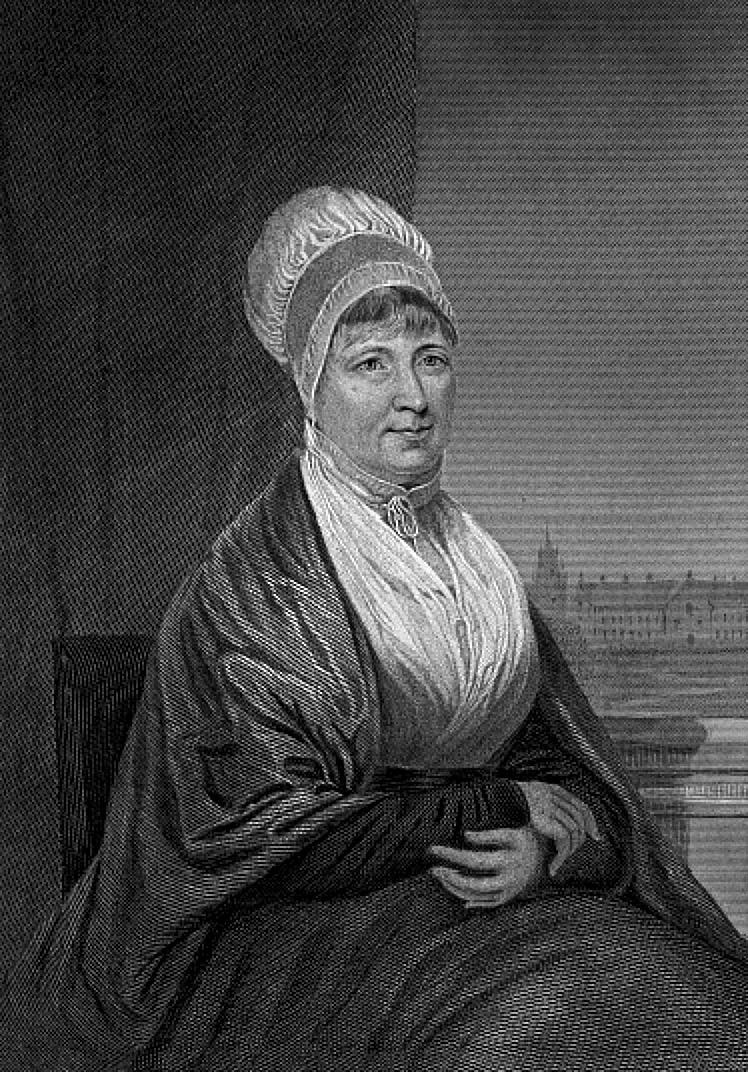 (1780-1845)
(1780-1845)
The first evidence of Elizabeth Fry’s reforming spirit was her own powerful transformation at age 18 from a frivolous girl who boldly wore scarlet-laced boots to Quaker meeting to a serious young woman who put social outreach above social pleasure. She went on to become one of the strongest voices for prison reform in England as well as an advocate for numerous other causes.
Elizabeth was the third of 12 children of a prominent banking family in Norwich, England. Although her parents were devout Quakers and active in the Society of Friends, the family wore bright and stylish clothing rather than typical Quaker dress. Elizabeth became fond of fashion and amusement and in her teen years often gave excuses for not attending meeting.
Her epiphany occurred in February 1798, when she met William Savery, a Quaker minister from America. “Today I felt there is a God,” she wrote after hearing him speak. “We had much serious talk, and what he said to me was like a refreshing shower on parched up earth.”
To the consternation of her family, Elizabeth took up the plain language and dress of the traditional Quakers. She devoted herself to helping the sick and needy and even set up a Sunday school in her family’s home to teach the poor children of her district to read. In July 1999 she met Joseph Fry, son of a successful merchant and also a plain Friend, and married him a year later. During the first 12 years of marriage Fry gave birth to eight children but managed to devote many hours to teaching boys and girls in the local workhouse and also became a preacher for the Society of Friends.
Despite all that she did, Fry wrote in her diary in 1812, “I fear that my life is slipping away to little purpose.” Soon after Fry wrote these plaintive words, Stephen Grellet, a prominent Quaker missionary and friend of the Fry family, paid a visit to Newgate Prison to learn of the conditions there. When he told Fry of the appalling way the women prisoners were treated, she decided she must see the conditions for herself. What she found was horrendous: over 300 women and their children in two wards and two cells, forced to sleep on the floor without nightclothes or bedding. Prisoners found guilty and those awaiting trial were commingled in these crowded and unsanitary conditions, and the mood was unruly and often violent.
Fry immediately organized a network of Friends to make warm clothing for the naked newborns she saw (rape by jailers was common, with resulting pregnancies and births), and she brought in clean straw for the women and children to lie on. In subsequent visits to Newgate, Fry prayed with the inmates and comforted the ill. The birth of three more children to the Frys and then the death of one of their daughters put a temporary halt to Fry’s prison visits, but in 1816 she returned. Touched by the plight of the children, who in effect were prisoners along with their mothers, she came up with the idea of a prison school to give them a better start in life.
Rebuffed by the men she approached for backing, she turned instead to her own sex and soon had a working committee of 12 women called the Association for the Improvement of the Female Prisoners in Newgate. This energetic band not only established the prison school but also introduced a system whereby women prisoners were supervised by a matron and female monitors, provided with materials and instruction in order to be able to make and sell goods, and received regular visits by volunteers who also read the Bible to them.
In 1818 Fry was asked to address a House of Commons committee about prison conditions. This was the first time a woman had been called by such a committee as an expert witness, and Fry, accustomed as she was to speaking in Quaker meeting, gave her testimony clearly and powerfully.
Impressed by what they knew of Fry’s work as well as by the clarity of her testimony, the Members of Parliament were receptive until she voiced her opinion that capital punishment was “evil and produced evil results.” At this time in England criminals could be executed for over 200 offenses, including stealing clothes or passing forged banknotes, and Fry had been grieved the previous year when she was unable to gain reprieve for two women sentenced to hang for forgery. A month after expressing her views to the House of Commons, Fry again took up the case of a woman condemned to the gallows for forgery, and for this she was branded by Home Secretary Lord Sidmouth as a “dangerous” person. He warned that Elizabeth Fry and other reformers were trying to “remove the dread of punishment in the criminal classes.”
Fry and her fellow prison reformers were more successful under the next Home Secretary, Sir Robert Peel, and the 1823 Gaols Act incorporated many of her recommendations. Unfortunately, Peel’s reforms did not apply to debtors’ prisons or local jails, and Fry and her brother Joseph Gurney toured throughout the British Isles, gathering evidence to bring about further reform legislation.
The ongoing legacy of Elizabeth Fry, the “godmother of prison reform”: In 2002, the Bank of England honored Fry’s work by putting her image on the 5 pound note. The Canadian Association of Elizabeth Fry Societies (CAEFS) celebrates National Elizabeth Fry Week during the week leading up Mother’s Day. And the groundwork she laid in caring for prisoners and opposing the death penalty continues to inform contemporary efforts.
By the 1820s Fry was a well-known personality whose advice was often sought on the subject of prison conditions. She also took up other causes: setting up District Visiting Societies to help the poor, libraries for the Coast Guard, and a nurse’s training school whose graduates accompanied Florence Nightingale to the Crimea. She campaigned for the London homeless, sought better treatment for patients in mental hospitals, and promoted the reform of workhouses and hospitals.
The young Queen Victoria was a great admirer of Fry, writing in her journal that she considered her a “very superior person.” Fry continued her work until October 1845, when she succumbed to a brief illness. Over 1,000 people stood in silent respect as the “Angel of Newgate” was laid to rest in the Society of Friends graveyard at Barking.
~ Leslie Hammond


